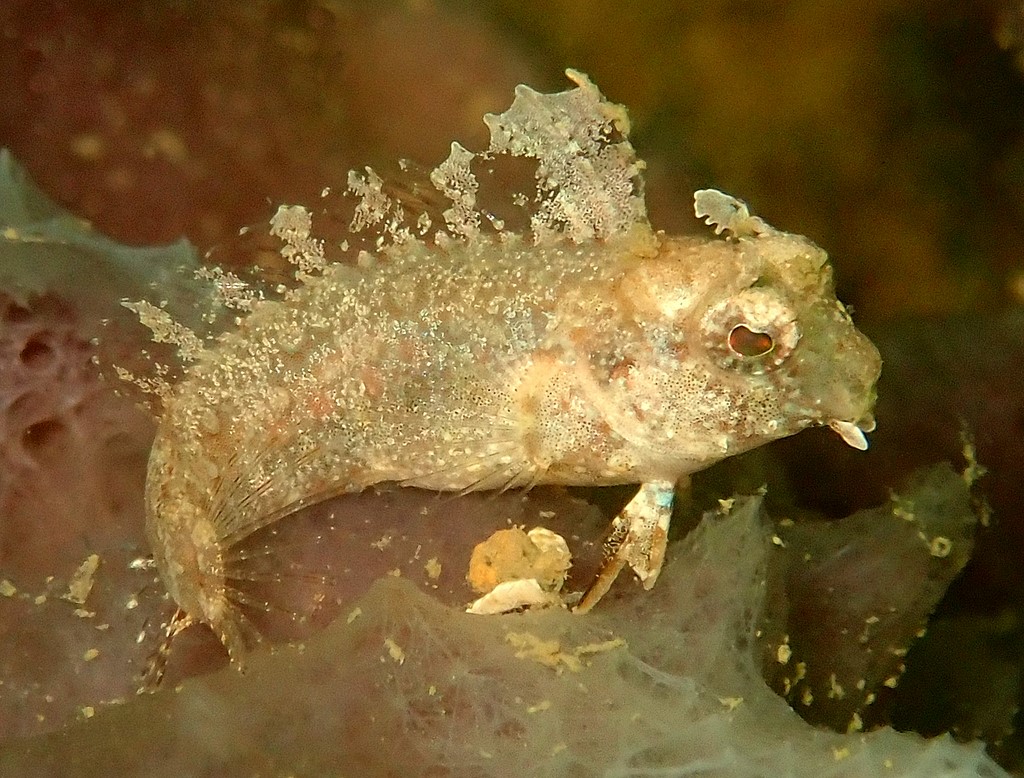PETROSCIRTES MITRATUS - (RUPPELL, 1830)
Picture courtesy of: Alain Daoulas
Actinopterygii (Gigaclass) > Actinopteri (Class) > Teleostei (Subclass) > Blenniiformes (Order) > Blennioidei (Suborder) > Blenniidae (Family) > Blenniinae (Subfamily) > Petroscirtes (Genus)
Blennie à mitre, Blennie mitrée, Blennechis à dorsale élevée, Crested sabre-tooth, Crested sabretooth blenny, Floral blenny, Floral fangblenny, Helmeted blenny, High-finned blenny, Highfin fangblenny, Miter blenny, Blom-blennie, Segelflossen-Säbelzahnschleimfisch, Hatatateginpo, ハタタテギンポ, 高鰭跳岩鳚, 跳岩鳚, 高鳍跳岩鳚,
Synonymes
Petrocirtes mitratus (Rüppell, 1830)
Petroscirtes barbatus (Peters, 1855)
Petroscirtes elatus (Jordan & Snyder, 1902)
Petroscirtes lienardi (Day, 1876)
Petroscirtes longifilis (Kner & Steindachner 1867)
Petroscirtes marmoratus (Liénard, 1891)
Petroskirtes barbatus (Peters, 1855)
Petroskirtes hypselopterus (Bleeker, 1855)
Petroskirtes marmoratus (Bleeker, 1875)
---------------------------
Description
Dorsal spines (total): 10-12, first spine elongate, subequal to or longer than 2nd spine, and distinctly longer than 4th spine, giving fin a notched appearance; Dorsal soft rays (total): 14-16; Anal spines: 2; Anal soft rays: 14-16; Pectoral fin rays: 13-16 rays. Premaxillary teeth: 20-33; Dentary teeth: 20-36. Symphysial dentary cirrus simple and broad. Supratemporal pores: 3-5 (usually: 5). Posterior nostril with well-developed flap on front rim. Max. length: 8.5 cm TL. Depth range: 1 - 8 m.
Color
Head, body and median fins mottled brownish with white speckles; About 5-6 dark bands or blotches on sides, the centre of each usually with whitish and dark-bordered ocelli; Pelvic fins with dark spot near base of outer rays.
Etymology
Petroscirtes: from Ancient Greek, pétra = stone, rock + from Greek, skirteo = to jump. Referring to Rüppell’s claim that Petroscirte mitratus was seen jumping between rocks out of the water hunting for small amphipods; However, since Petroscirte mitratus is not amphibious, Rüppell may have confused it with Alticus saliens, observing both blennies at Jubal Island (Egypt, Red Sea) and thinking they were conspecific.
mitratus: from Latin = wearing the mitre. The mitre, also spelled miter, is a type of headgear now known as the traditional, ceremonial head-dress of bishops and certain abbots in the Roman Catholic Church, as well as in the Anglican Communion, some Lutheran churches, and also bishops and certain other clergy in the Eastern Orthodox churches, Eastern Catholic Churches and the Oriental Orthodox Churches.
Original description: Petroscirtes mitratus Rüppell, 1830 - Type locality: Jubal Island, Egypt, Red Sea.
Distribution
Red Sea; Indo-West Pacific: South Africa, East Africa, Persian Gulf, Seychelles, Comoros, Madagascar and Mascarenes (La Réunion, Mauritius, Rodrigues), east to Samoa and Tonga, north to Kagoshima Prefecture (southern Japan), south to Rottnest Island (Western Australia), One Tree Island (Queensland, Australia), and New Caledonia.
Biology
Adults are found solitary or in small groups in shallow protected lagoons and reef flats with algal and seagrass clumps. Juveniles often in floating Sargassum weeds and maybe dispersed over great distances. They swim with the tail oriented vertically. Oviparous, distinct pairing. Eggs are demersal and adhesive, and are attached to the substrate via a filamentous, adhesive pad or pedestal. Empty mollusk shells are used for nesting. Larvae are planktonic, often found in shallow, coastal water. Captured at the surface using a hand net. This species is collected for the aquarium trade.
Last update: 17, July 2024
Blennie à mitre, Blennie mitrée, Blennechis à dorsale élevée, Crested sabre-tooth, Crested sabretooth blenny, Floral blenny, Floral fangblenny, Helmeted blenny, High-finned blenny, Highfin fangblenny, Miter blenny, Blom-blennie, Segelflossen-Säbelzahnschleimfisch, Hatatateginpo, ハタタテギンポ, 高鰭跳岩鳚, 跳岩鳚, 高鳍跳岩鳚,
Synonymes
Petrocirtes mitratus (Rüppell, 1830)
Petroscirtes barbatus (Peters, 1855)
Petroscirtes elatus (Jordan & Snyder, 1902)
Petroscirtes lienardi (Day, 1876)
Petroscirtes longifilis (Kner & Steindachner 1867)
Petroscirtes marmoratus (Liénard, 1891)
Petroskirtes barbatus (Peters, 1855)
Petroskirtes hypselopterus (Bleeker, 1855)
Petroskirtes marmoratus (Bleeker, 1875)
---------------------------
Description
Dorsal spines (total): 10-12, first spine elongate, subequal to or longer than 2nd spine, and distinctly longer than 4th spine, giving fin a notched appearance; Dorsal soft rays (total): 14-16; Anal spines: 2; Anal soft rays: 14-16; Pectoral fin rays: 13-16 rays. Premaxillary teeth: 20-33; Dentary teeth: 20-36. Symphysial dentary cirrus simple and broad. Supratemporal pores: 3-5 (usually: 5). Posterior nostril with well-developed flap on front rim. Max. length: 8.5 cm TL. Depth range: 1 - 8 m.
Color
Head, body and median fins mottled brownish with white speckles; About 5-6 dark bands or blotches on sides, the centre of each usually with whitish and dark-bordered ocelli; Pelvic fins with dark spot near base of outer rays.
Etymology
Petroscirtes: from Ancient Greek, pétra = stone, rock + from Greek, skirteo = to jump. Referring to Rüppell’s claim that Petroscirte mitratus was seen jumping between rocks out of the water hunting for small amphipods; However, since Petroscirte mitratus is not amphibious, Rüppell may have confused it with Alticus saliens, observing both blennies at Jubal Island (Egypt, Red Sea) and thinking they were conspecific.
mitratus: from Latin = wearing the mitre. The mitre, also spelled miter, is a type of headgear now known as the traditional, ceremonial head-dress of bishops and certain abbots in the Roman Catholic Church, as well as in the Anglican Communion, some Lutheran churches, and also bishops and certain other clergy in the Eastern Orthodox churches, Eastern Catholic Churches and the Oriental Orthodox Churches.
Original description: Petroscirtes mitratus Rüppell, 1830 - Type locality: Jubal Island, Egypt, Red Sea.
Distribution
Red Sea; Indo-West Pacific: South Africa, East Africa, Persian Gulf, Seychelles, Comoros, Madagascar and Mascarenes (La Réunion, Mauritius, Rodrigues), east to Samoa and Tonga, north to Kagoshima Prefecture (southern Japan), south to Rottnest Island (Western Australia), One Tree Island (Queensland, Australia), and New Caledonia.
Biology
Adults are found solitary or in small groups in shallow protected lagoons and reef flats with algal and seagrass clumps. Juveniles often in floating Sargassum weeds and maybe dispersed over great distances. They swim with the tail oriented vertically. Oviparous, distinct pairing. Eggs are demersal and adhesive, and are attached to the substrate via a filamentous, adhesive pad or pedestal. Empty mollusk shells are used for nesting. Larvae are planktonic, often found in shallow, coastal water. Captured at the surface using a hand net. This species is collected for the aquarium trade.
Last update: 17, July 2024
